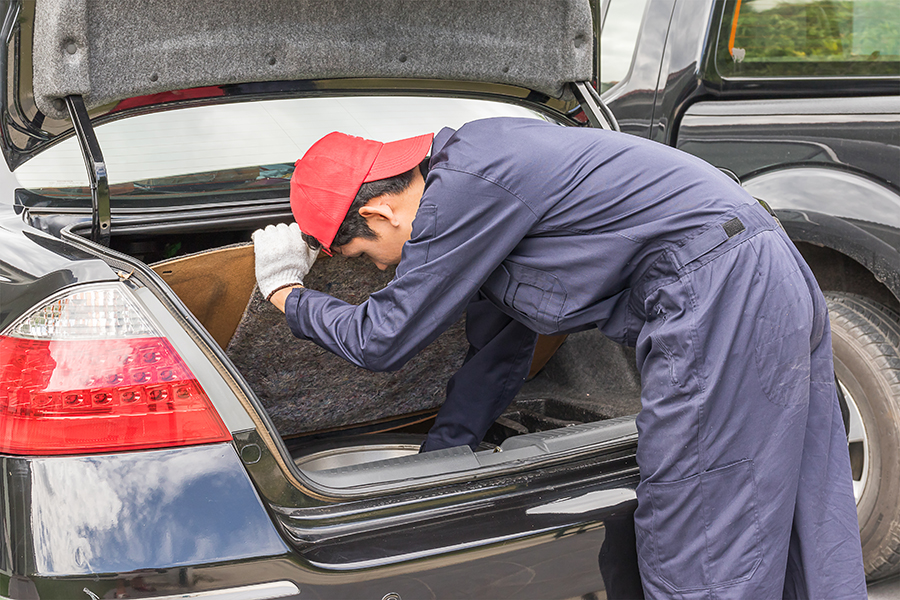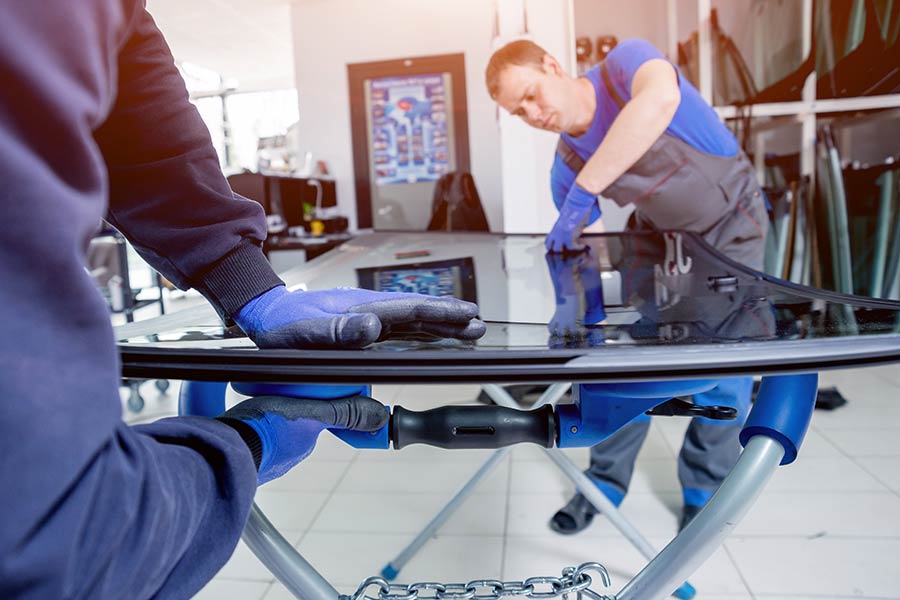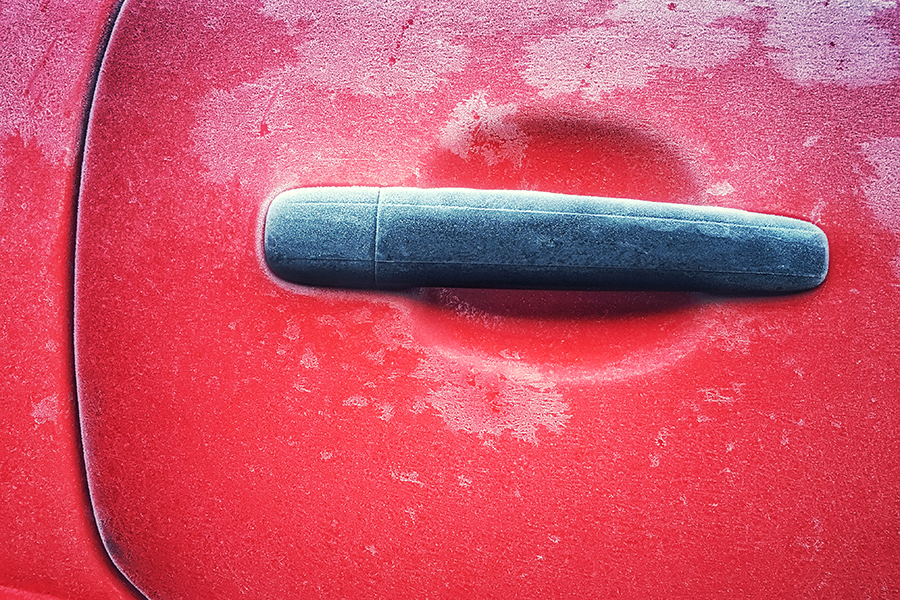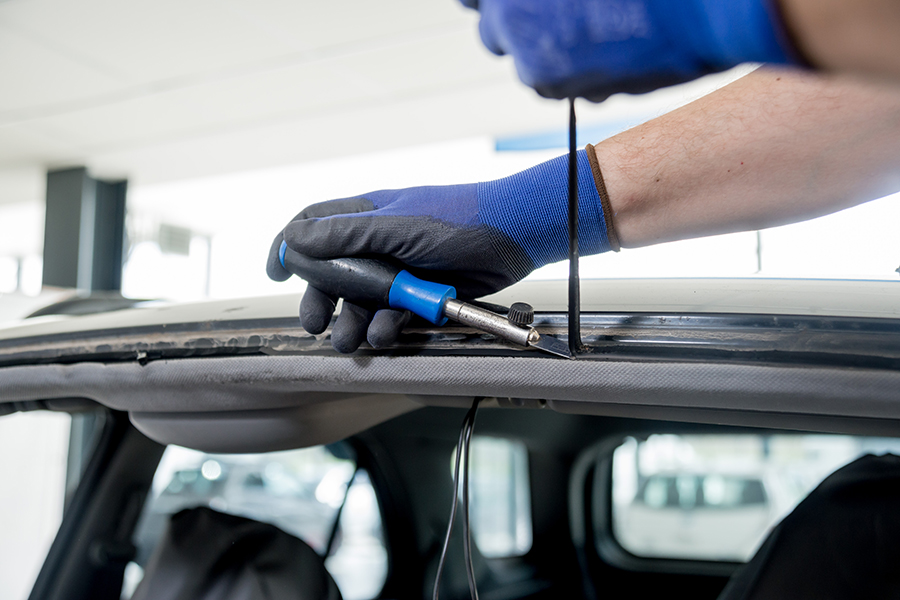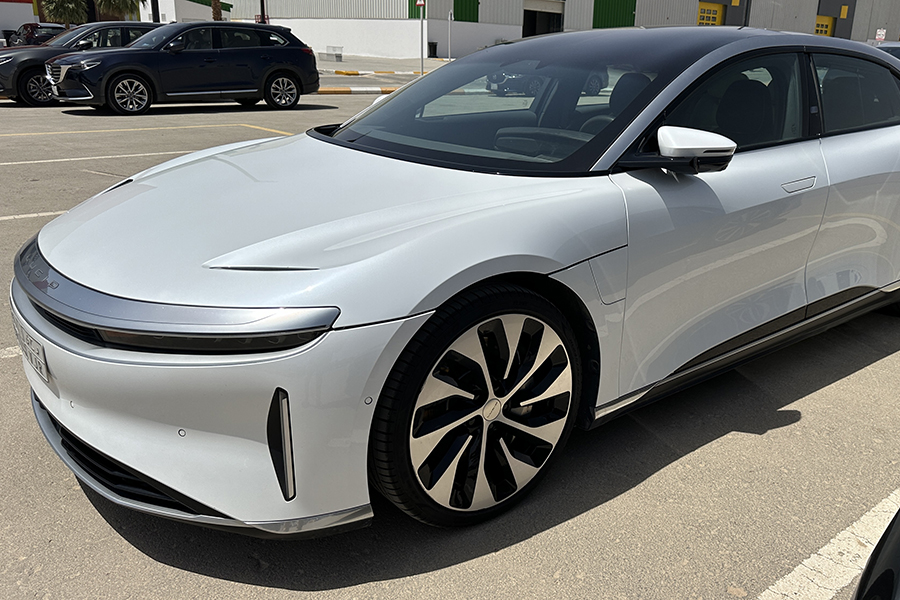Did you know 90% of car owners will face a dent issue at some point? That's a lot of us looking for a quick fix. Trunk dent repair doesn't have to be a headache or empty your wallet. Whether it's from a minor bump or a more serious collision, there's always a way to get your car looking sharp again without spending a fortune. We're diving into the nitty-gritty of fixing those pesky trunk dents, from DIY tricks that save the day to knowing when it's time to call in the pros. So, if your car's rear end has seen better days, stick around. We're about to make things a whole lot smoother.
Key Takeaways
- Fixing a trunk dent can often be a DIY job if it's small and on a flat surface. Look into methods like using a plunger or boiling water to pop the dent out.
- For larger or more complex dents, hiring a professional is the best route. They have the tools and experience to do the job right.
- Paintless Dent Repair (PDR) is a cost-effective and quick method for fixing dents without damaging the paint, ideal for newer cars.
- Dents on specific parts like the tailgate or rear hatch may require different repair techniques, so it's important to understand the type of dent you're dealing with.
- Preventing trunk dents is key. Simple steps like parking further away from other cars and using protective barriers can save you time and money.
- If you're unsure about any aspect of trunk dent repair, consulting the FAQs or a professional can provide clarity and ensure your car is handled properly.
Understanding Trunk Dents
Common Causes
Trunk dents happen for many reasons. Collisions are a big one. They can cause a lot of damage to the trunk. Sometimes, things fall on cars. Like tree branches during a storm. These can leave dents too.
Parking lots are tricky places. Cars often get hit or bumped there. These are called parking lot mishaps. Even small hits can leave marks on the trunk.
Types of Dents
Not all dents are the same. Some dents are small and shallow. These don't go deep into the car's surface. They're easier to fix.
Then, there are deep, sharp dents. These go far into the car's body. They're harder to repair because they're so deep.
Some dents bend the metal. We call these creased or folded dents. They look like the metal has folded over. These are tough to fix because the shape of the trunk changes.
Impact on Vehicle
Dents make cars look bad. This is about reduced aesthetic appeal. People like their cars to look nice and new. Dents spoil that look.
Dents can lead to bigger problems, like rust and corrosion. When the car's paint cracks, water gets in. This causes rust. Over time, it harms the car even more.
The value of a car goes down when it has dents. This is about the possible resale value decrease. When people buy cars, they don't want ones with damage. So, dented cars sell for less money.
DIY Trunk Dent Repair
Tools Needed
To start fixing a dent in your trunk, you need the right tools. Dent pullers and suction cups are key. They help pull out the dent without harming your car's paint. You also need rubber mallets and hammers. These tools help tap out any small dents from the inside. Lastly, heat guns and hairdryers are useful. They make the metal more flexible, making it easier to fix the dent.
Step-by-Step Guide
First, clean the dented area well. Dirt or debris can get in the way of repair work. Next, use a dent puller or suction cup to gently pull the dent outwards. It might take a few tries to get it right.
After pulling out the dent, there might still be some uneven spots. Use a rubber mallet or hammer to lightly tap these areas from the inside of the trunk. Be gentle to avoid making new dents.
Finally, smooth and polish the surface. This helps your trunk look shiny and new again. If you have paint or a finish that was damaged, now is the time to touch it up.
Safety Precautions
Always wear protective gloves and goggles when working on your car. This keeps you safe from sharp edges and flying debris. Make sure your car is parked on a flat surface to prevent it from moving while you work.
Be careful not to use too much force. Too much pressure can make things worse, causing more damage to your trunk.
Professional Trunk Dent Repair
When to Seek Help
Sometimes, DIY methods just don't cut it. This is true for trunk dents that are deep or have complex shapes. It's best to consult a professional in these cases.
They have the right tools and experience. If you tried fixing a dent yourself and it didn't work, it's time to seek professional help.
For high-value vehicles, expert advice is crucial. They can ensure the car's value stays high.
Choosing a Service
Finding the right service is key. Start by researching local repair shops. Look for ones that specialize in dent repair.
Next, check reviews and ratings online. This helps you see what other customers say about their service.
It's also smart to compare prices and services offered by different shops. This way, you find the best deal.
Cost Considerations
Let's talk money. Minor repairs usually don't cost too much. But several factors can change this.
The size of the dent matters a lot. Bigger dents often mean higher costs. Where the dent is can also affect the price.
Insurance might cover some costs, especially if another vehicle caused the damage. It's worth checking with your insurance company.
Paintless Dent Repair (PDR)
What is PDR
Paintless Dent Repair (PDR) is a method used to fix dents in cars. It does not need painting. This technique removes small dents and damage from a vehicle's body. Experts do this by reaching behind the dent and pushing it back out.
PDR works well for fixing minor dents and dings. It is often used on car doors, roofs, and trunks. After professional trunk dent repair, PDR can help maintain the car's look without repainting.
Benefits of PDR
One major advantage of PDR is it saves money. It costs less than traditional dent repair methods. This is because there is no need for new paint or fillers.
Another benefit is it saves time. Many PDR jobs can be done in just a few hours. This means you get your car back faster.
It also keeps the original paint intact. This is important for keeping your car's value high. Cars with their original paint are worth more than those that have been repainted.
PDR Process
The first step in PDR is to check the dent closely. Experts look at the size and location of the dent. They decide if PDR is the best way to fix it.
Next, they use special tools to gently push the dent back into place. These tools allow them to reach behind the car's panel and massage the dent out.
Finally, they check the area again for any small imperfections. They make sure the surface is smooth and looks good as new.
Tailgate Dent Repair
Causes of Damage
Tailgate dents can happen for many reasons. Weather plays a big part. Hail, for example, can cause small to large dents.
Then there are mistakes made by people. Maybe someone backed into something or hit the tailgate by accident. These things happen more often than we think.
The environment around us also adds risks. Things like tree branches or debris flying around during storms can slam into the tailgate. This can leave marks or dents that weren't there before.
DIY vs Professional
When it comes to fixing a dent in your tailgate, you have two choices: do it yourself or hire a pro.
Doing it yourself might save money at first. But, it requires skills and tools you might not have. If you try without knowing how, you could make it worse.
Professional repairs cost more, but for good reason. Pros have the right tools and experience. They make sure the job is done right. This means your tailgate looks good as new without risking further damage.
Repair Steps
To fix a dent on your own, start by cleaning the area well. Dirt and grime can get in the way of the repair process.
Next, use the right tools to gently push or pull the dent back into place. Tools vary based on the dent's size and location.
Finally, inspect your work. Make sure there are no more bumps or uneven spots. Finish with polishing to make it shine like before.
Rear Hatch Dent Repair
Common Issues
Rear hatch dents can be tricky. Some areas are hard to reach. This makes the repair tough. Paint damage is another worry. If not careful, the paint might crack or peel off. Using tools the wrong way can bend the metal more. It's important to know what you're doing.
Repair Methods
There are a few ways to fix dents on the rear hatch. Suction-based methods work well for small and medium dents. They pull the dent out without harming the paint. For bigger dents, hammer and dolly techniques are useful. But, they need skill to avoid more damage.
Using heat and cold can also help. Heat expands the metal, and cold contracts it. This can make the dent pop out. But, it's crucial to use this method carefully to avoid paint damage.
Preventive Measures
To stop dents before they happen, using car covers is smart. They protect against hail and falling branches. Parking carefully can also prevent accidents. Choose spots away from carts and busy areas.
Regular vehicle inspections catch small issues before they turn into big ones. Checking your car often can save you trouble later.
Preventing Trunk Dents
Parking Tips
Parking smart can save your trunk from unwanted dents. It's simple but effective.
Park away from crowded areas to avoid cars squeezing next to you. This reduces the chance of someone hitting your car with their door or bumper.
Avoid parking under trees. While shade is nice, falling branches can cause big dents.
Lastly, choose covered parking when possible. It protects your car from weather damage and reduces the risk of dents from hail or debris.
Using Protective Gear
When working around your car, protective gear is key. It keeps both you and your car safe.
Wear gloves to protect your hands when loading or unloading heavy items from your trunk. This prevents slips that could dent the car or hurt you.
Use goggles to shield your eyes from any flying debris, especially when working close to the ground or if windy conditions could kick up dust and small stones.
Consider wearing a dust mask if you're cleaning around your car or doing any work that might stir up particles. This keeps you healthy and focused on protecting your car from dents and scratches.
Regular Maintenance
Keeping up with your car's health can prevent trunk dents before they happen.
Schedule periodic check-ups to catch any issues early, including potential weak spots on your trunk that could easily dent.
Keep the car clean to spot dents early. Dirt and grime can hide small dents, making them harder to fix in time.
Apply wax to protect the paint. A good layer of wax adds a barrier against minor scratches and dings that could lead to bigger dents.
FAQs on Trunk Dent Repair
Cost of Repairs
Repairing a trunk dent can cost between $50 to $150 for minor fixes. The price goes up for bigger dents. Why? The size, depth, and location affect the cost. Also, the type of your car matters. Luxury cars often cost more to fix.
There could be extra fees. Sometimes, there's damage you can't see right away. This means the final bill might be higher than expected. Shops might charge more for matching the paint color too.
Duration of Repairs
Fixing a small dent can take just a few hours. But if the damage is bad, it could take days. The repair time depends on how busy the shop is and the dent's severity.
Larger or more complex dents need more work. This makes the repair take longer. Also, if parts need to be ordered, this can add to the wait time.
Effectiveness of DIY
For small dents, DIY repair has a good chance of success. Many people have fixed minor dents with kits from auto stores. But, it's important to use the right tools and follow instructions carefully.
Complex damage is harder to fix on your own. Without experience, you might not get the results you want. Plus, using the wrong technique can cause more harm to your car. It's best to know when to call a professional.
Closing Thoughts
We've tackled everything from understanding the nuts and bolts of trunk dents to diving into DIY fixes and when it's time to call in the pros. Whether you're dealing with a pesky tailgate dent or a full-on rear hatch makeover, the key is knowing your options and choosing the best route for your ride. And hey, don't forget about dodging those dents in the first place with some savvy prevention tips. Got questions? We've got answers. Dive into our FAQ section for the nitty-gritty on keeping your trunk in tip-top shape. Remember, your car's rear end deserves some love too, so don't wait until it's too late. Take action now, keep that trunk looking sharp, and drive with pride. Ready to tackle those dents head-on or keen to keep them at bay? Let's get to it!
Frequently Asked Questions
Can I fix a trunk dent myself?
Absolutely! For small dents, DIY methods like using a plunger or a dent repair kit can work wonders. Just be gentle to avoid further damage.
Is paintless dent repair good for trunk dents?
Yes, it's fantastic for minor dings and dents where the paint hasn't been compromised. It's quick, cost-effective, and doesn't affect your car's original paint job.
How much does professional trunk dent repair cost?
It varies widely based on the dent's size and depth, but expect anything from $50 to several hundred dollars. Getting quotes from a few shops is a wise move to find the best deal.
Will fixing a trunk dent require repainting?
Not always. If the paint isn't cracked or chipped, techniques like Paintless Dent Repair (PDR) can fix the dent without needing a touch-up.
How can I prevent trunk dents in the future?
Mindfulness is key. Park away from carts and other vehicles when possible, and load/unload carefully. Using protective accessories like bumper guards can also help shield against accidental knocks.
What's the difference between tailgate and rear hatch dent repair?
The main difference lies in the vehicle type. Tailgate repairs are typically for pickup trucks, while rear hatch repairs are for SUVs and hatchbacks. The repair principles are similar, but accessibility might differ.
Are DIY repair kits worth it for trunk dents?
For minor dents, yes, they can be quite effective. However, if you're unsure or the dent is large or complex, consulting a professional might save you from accidentally causing more harm.
